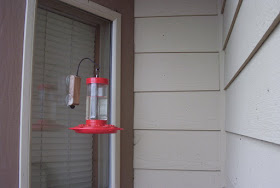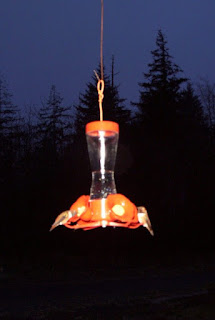 |
| Dusk and time to replenish for the night. |
It may take up to an hour for a hummingbird to awaken from a state of torpor. But this post isn't to discuss the whys and wherefores for torpor. There are many other sites that cover that topic. This is about hummingbird behavior.
One morning I awoke to see a hummingbird in torpor sitting on our feeding. This had never happened before and I assume he arrived late while migrating, was very hungry and as it grew dark he had no time to search out a safer place to sleep. Although on the north side of our house, this feeder is in a sheltered corner.
 |
| The sheltered feeder where a hummer spent the night in torpor. He slept later than others, but was left undisturbed. |
Hummingbird protocol? An unwritten law that you don't disturb a fellow bird during torpor? Probably.
If you want to know more about hummingbird torpor, I found this site enlightening.
A Link to "Lisa's Garden" about hummingbird torpor
 |
| Not the best choice in feeders. |
 |
| A recommended feeder that unscrews completely to allow thorough cleaning of every nook and cranny. |
Since mold is a problem in our area, a feeder that comes completely apart for thorough cleaning is very important. I recommend only hummingbird feeders that dismantle completely to allow every part to be cleaned between each refilling.
Peace and Blessings.
No comments:
Post a Comment